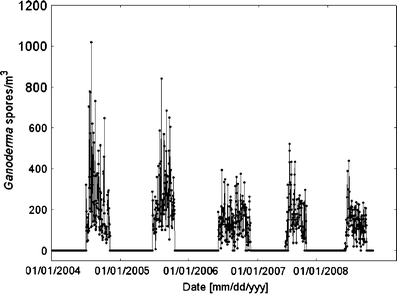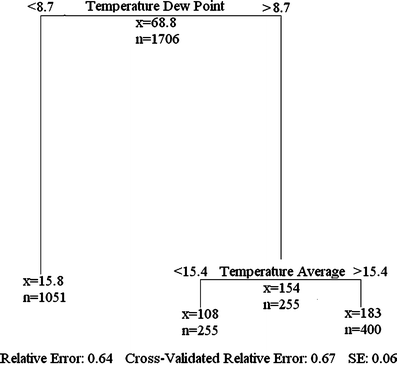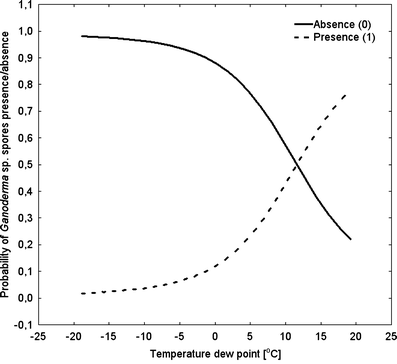The effects of meteorological factors on the occurrence of Ganoderma sp. spores in the air
- PMID: 20512355
- PMCID: PMC3043254
- DOI: 10.1007/s00484-010-0329-x
The effects of meteorological factors on the occurrence of Ganoderma sp. spores in the air
Abstract
Ganoderma sp. is an airborne fungal spore type known to trigger respiratory allergy symptoms in sensitive patients. Aiming to reduce the risk for allergic individuals, we analysed fungal spore circulation in Szczecin, Poland, and its dependence on meteorological conditions. Statistical models for the airborne spore concentrations of Ganoderma sp.-one of the most abundant fungal taxa in the area-were developed. Aerobiological sampling was conducted over 2004-2008 using a volumetric Lanzoni trap. Simultaneously, the following meteorological parameters were recorded: daily level of precipitation, maximum and average wind speed, relative humidity and maximum, minimum, average and dew point temperatures. These data were used as the explaining variables. Due to the non-linearity and non-normality of the data set, the applied modelling techniques were artificial neural networks (ANN) and mutlivariate regression trees (MRT). The obtained classification and MRT models predicted threshold conditions above which Ganoderma sp. appeared in the air. It turned out that dew point temperature was the main factor influencing the presence or absence of Ganoderma sp. spores. Further analysis of spore seasons revealed that the airborne fungal spore concentration depended only slightly on meteorological factors.
Figures




Similar articles
-
Artificial neural network models of relationships between Alternaria spores and meteorological factors in Szczecin (Poland).Int J Biometeorol. 2008 Nov;52(8):859-68. doi: 10.1007/s00484-008-0182-3. Epub 2008 Sep 23. Int J Biometeorol. 2008. PMID: 18810504
-
Hourly predictive artificial neural network and multivariate regression trees models of Ganoderma spore concentrations in Rzeszów and Szczecin (Poland).Sci Total Environ. 2011 Feb 1;409(5):949-56. doi: 10.1016/j.scitotenv.2010.12.002. Epub 2010 Dec 23. Sci Total Environ. 2011. PMID: 21183203
-
Seasonal variation of Ganoderma spore concentrations in urban and suburban districts of the city of Szczecin, Poland.Ann Agric Environ Med. 2015;22(1):6-10. doi: 10.5604/12321966.1141360. Ann Agric Environ Med. 2015. PMID: 25780819
-
Annual variation of fungal spores in atmosphere of Porto: 2003.Ann Agric Environ Med. 2005;12(2):309-15. Ann Agric Environ Med. 2005. PMID: 16457491
-
Aerobiological modelling II: A review of long-range transport models.Sci Total Environ. 2022 Nov 1;845:157351. doi: 10.1016/j.scitotenv.2022.157351. Epub 2022 Jul 13. Sci Total Environ. 2022. PMID: 35842165 Review.
Cited by
-
Assessing Performance of Spore Samplers in Monitoring Aeromycobiota and Fungal Plant Pathogen Diversity in Canada.Appl Environ Microbiol. 2018 Apr 16;84(9):e02601-17. doi: 10.1128/AEM.02601-17. Print 2018 May 1. Appl Environ Microbiol. 2018. PMID: 29475862 Free PMC article.
-
Effects of meteorological factors on the composition of selected fungal spores in the air.Aerobiologia (Bologna). 2015;31(1):63-72. doi: 10.1007/s10453-014-9347-1. Epub 2014 Sep 12. Aerobiologia (Bologna). 2015. PMID: 25750477 Free PMC article.
-
Application of redundancy analysis for aerobiological data.Int J Biometeorol. 2015 Jan;59(1):25-36. doi: 10.1007/s00484-014-0818-4. Epub 2014 Mar 27. Int J Biometeorol. 2015. PMID: 24671406
-
Forecasting methodologies for Ganoderma spore concentration using combined statistical approaches and model evaluations.Int J Biometeorol. 2016 Apr;60(4):489-98. doi: 10.1007/s00484-015-1045-3. Epub 2015 Aug 13. Int J Biometeorol. 2016. PMID: 26266481
-
A systematic review of outdoor airborne fungal spore seasonality across Europe and the implications for health.Sci Total Environ. 2022 Apr 20;818:151716. doi: 10.1016/j.scitotenv.2021.151716. Epub 2021 Nov 17. Sci Total Environ. 2022. PMID: 34800445 Free PMC article.
References
-
- Bishop C. Neural networks for pattern recognition. Oxford: University Press; 1995.
-
- British Aerobiology Federation . Airborne pollens and spores. A guide to trapping and counting. 1. Rotherham: National Pollen and Hayfever Bureau; 1995.
-
- Breiman L, Friedma JH, Olshen RA, Stone CG. Classification and regression trees. Belmont: Wadsworth International Group; 1984.
-
- Calderon C, Lacey J, McCartney HA, Rosas I. Seasonal and diurnal variation of airborne basidiomycete spore concentrations in Mexico City. Grana. 1995;34:260–268. doi: 10.1080/00173139509429055. - DOI
MeSH terms
LinkOut - more resources
Full Text Sources

